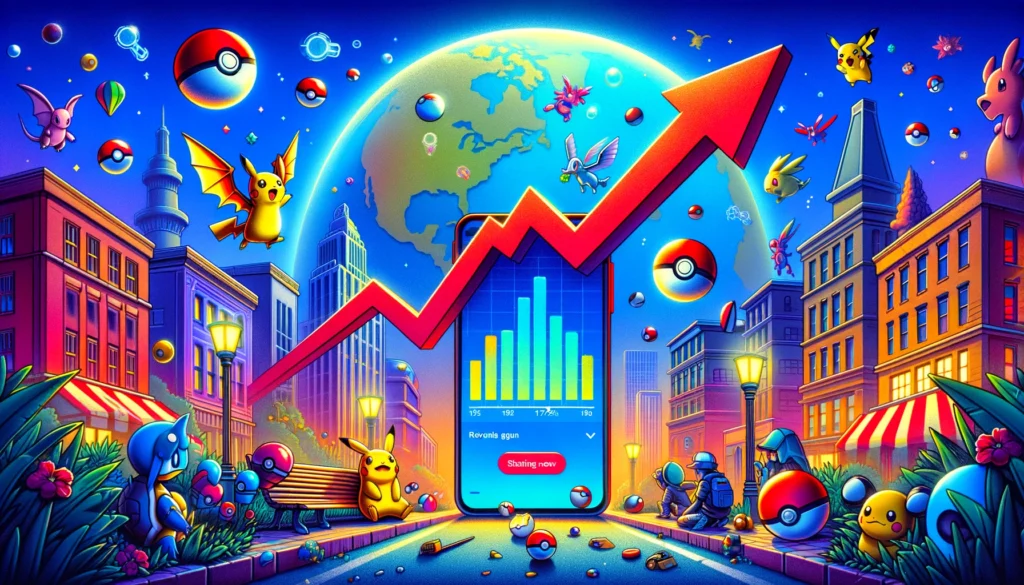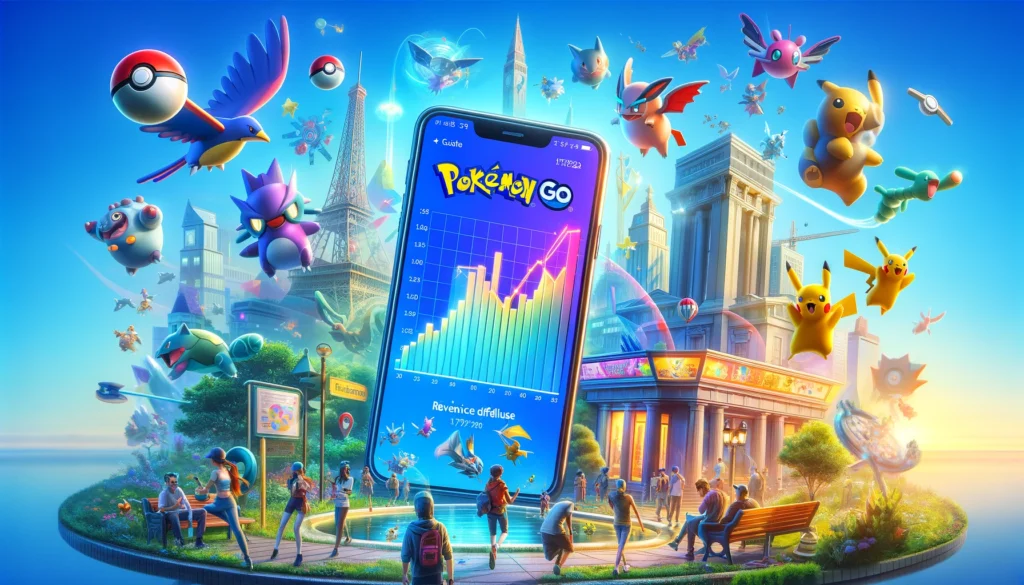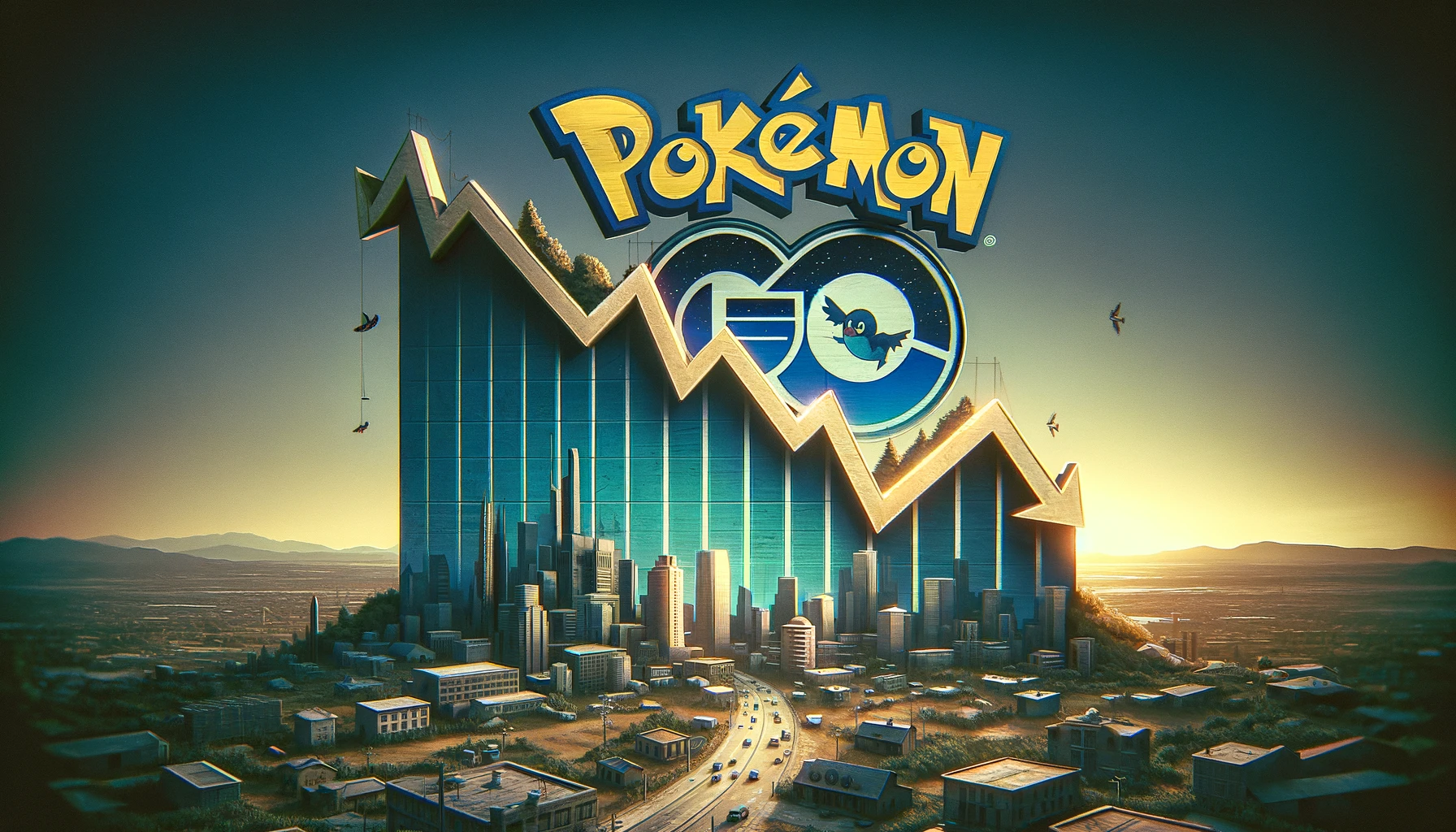In the ever-evolving landscape of mobile gaming, few titles have managed to capture and sustain a global following as significantly as Pokémon GO. Since its groundbreaking launch in 2016, the game has not only redefined the intersection of mobile gaming and physical activity but has also established a robust financial model primarily fueled by in-game purchases. However, the latest fiscal reports illuminate an unexpected downturn, marking the year 2023 as the lowest revenue-generating period since 2017, with earnings reported at $566.38 million. This decline, as highlighted by industry analysts, signals a critical juncture for Niantic, the game’s developer, prompting a reevaluation of recent strategic decisions that have seemingly alienated a portion of its player base. As we scrutinize the factors contributing to this fiscal anomaly—from the controversial adjustments in pricing strategies to broader market dynamics—questions about the future sustainability of Pokémon GO’s business model and its impact on the wider mobile gaming ecosystem surface, inviting a closer examination of the choices facing Niantic and the potential ripple effects on its audience and stakeholders.
Financial Downturn Detailed

In 2023, Pokémon GO experienced a significant financial downturn, with its annual revenue plummeting to $566.38 million, the lowest since 2017, amid controversial in-game decisions and changing player dynamics. This notable revenue decline during the financial year marks a critical juncture for the once soaring franchise. According to a new report, the monthly revenue dropped consistently, bringing the year’s total to its lowest earning peak since its unprecedented rise to fame. The decision to increase the price of Remote Raid Passes and impose limitations on their usage played a pivotal role in this downturn. These changes, seemingly minor, had a profound impact on player engagement and financial contributions.
Despite this financial setback, Pokémon GO continues to innovate by expanding its Pokedex and organizing captivating events, aiming to rejuvenate its community and restore its financial health. The financial downturn detailed in recent analyses raises pertinent questions about the game’s strategic direction and its ability to adapt to the evolving landscape of mobile gaming. This downturn, while concerning, also underscores the volatile nature of the mobile games market, where billion globally successes can face sudden shifts in fortune.
Analyzing the Revenue Dip

To understand the decline in Pokemon GO’s revenue in 2023, it is crucial to examine several influencing factors. The aftermath of the pandemic, increasing competition within the mobile gaming market, and the game’s response through feature updates are key areas to explore. These elements collectively offer insight into the game’s financial performance and potential strategies for recovery.
Pandemic Impact Analysis
Analyzing the pandemic’s impact reveals that Pokemon GO’s revenue trajectory experienced a notable decline in 2023, marking its least profitable year since 2017. This downturn, part of an unprecedented revenue decline, has prompted scrutiny into the factors influencing the financial year’s results. Here are three critical points:
- Pandemic Impact Analysis: The global health crisis significantly altered player spending habits, contributing to GOs drop in revenue.
- Remote Raids and Player Engagement: Adjustments in the pricing and availability of Remote Passes have directly impacted participation levels, despite efforts to maintain interest through ongoing Timeless Travels.
- Lowest in Five: With Pokémon GO monthly revenue hitting its lowest point in five years, the pandemic’s long-term effects continue to shape the game’s economic landscape.
Competition Intensifies Market
The intensification of competition within the mobile gaming sector has been identified as a significant factor contributing to the observed decline in Pokemon GO’s revenue in 2023. With the market becoming increasingly saturated, players are presented with a plethora of options, diluting the player base that was once predominantly loyal to Pokemon GO. Despite grossing $566.38 million, the lowest since 2017, the game faces challenges in maintaining its revenue due to controversial decisions that may have affected player engagement, such as increased prices for Remote Passes and PokeCoins. Nevertheless, the continuous introduction of new features and content demonstrates a commitment to relevance and player satisfaction. However, the financial year 2023 highlights the critical impact of competition on revenue decline, emphasizing the need for innovative strategies to retain and expand the player base amidst a fiercely competitive market.
Feature Updates Response
In response to the significant revenue dip observed in 2023, Pokémon GO has rolled out a series of feature updates and new content, aiming to rejuvenate player engagement and financial performance. This strategic move underscores the need to reverse the trend that marked the lowest earnings since 2017, amidst a challenging environment for mobile games.
- Introduction of New Content: Efforts to boost playing experience with fresh, engaging in-game events.
- Feature Updates Response: Enhancements aimed at addressing player feedback, particularly around controversial decisions that may have impacted participation.
- Revitalizing Player Engagement: Strategies to reconnect with the community, ensuring the game remains a vital part of their mobile gaming routine.
These actions reflect a committed response to the revenue decline, emphasizing the importance of maintaining a vibrant player base in the financial year 2023.
Impact on Niantic and Stakeholders
Niantic’s significant reduction in annual revenue for Pokemon GO in 2023 has presented a complex challenge for both the company and its stakeholders, prompting an urgent reassessment of strategic decisions and financial forecasting. This unprecedented revenue decline in the latest financial year marks a pivotal moment for Niantic, as it seeks to navigate through the implications of the lowest earning year since 2017. The decisions ahead are crucial in determining the future trajectory of Pokemon GO and its sustainability in the competitive mobile games market.
| Year | Revenue (in million) | Remark |
|---|---|---|
| 2023 | Lowest since 2017 | Unprecedented decline |
| 2022 | – | Prior to decline |
| February | – | Specific month analyzed |
| Lifetime Revenue | – | Cumulative earnings |
| Financial Year | 2023 | Latest reporting period |
The revenue drop raises significant concerns among stakeholders regarding the game’s future and Niantic’s ability to maintain player engagement through new content and features. As the company endeavors to reverse this downturn, stakeholders remain watchful, eager to see if the strategies employed will enhance the game’s appeal and restore its financial health. This period of uncertainty places a heightened emphasis on Niantic’s next moves in the ever-evolving landscape of mobile gaming.
Factors Behind the Decline
Understanding the complex challenges faced by Niantic and its stakeholders due to the significant revenue drop, it becomes imperative to explore the underlying factors contributing to this decline in Pokemon GO’s financial performance. This analysis aims to provide clarity and insight into the reasons behind the downturn, emphasizing the importance of community engagement and strategic decision-making in maintaining the game’s profitability and relevance.
- Controversial Pricing Decisions: Increasing the price of Remote Passes and PokeCoins has led to a divided community. This decision significantly impacted participation in Remote Raids, a critical event where players participate from various locations, leading to a noticeable drop compared to previous years.
- Economic and Development Challenges: External factors such as inflation, coupled with changes made by the developers, have influenced Pokemon GO’s revenue. These factors include the balancing act of introducing new content and features while ensuring that the game remains accessible and enjoyable for a broad audience.
- Player Engagement and Perception: Despite efforts to inject new content and maintain relevance, the revenue decline has raised concerns about Pokemon GO’s future. It highlights the challenge of keeping gameplay interesting and engaging to prevent a further decrease in Pokemon GO players’ participation and investment.
Player Base Evolution
Analyzing the evolution of Pokemon GO’s player base reveals a complex interplay between developer decisions, external economic factors, and player engagement, all contributing to the game’s fluctuating popularity and revenue. Despite the revenue decline in the latest financial year, the commitment to playing mobile games, especially Pokemon GO, continues. This dedication is partly due to Niantic’s efforts to release new content, aiming to spark interest and maintain a vibrant community.
| Year | Key Player Base Evolution Highlights |
|---|---|
| 2017 | Initial surge in popularity, establishing a strong foundation |
| 2020 | Renewed interest during global lockdowns, peak in engagement |
| 2023 | Decline in revenue, yet strategic updates to sustain interest |
The 2023 revenue decline raised concerns about Pokemon GO’s future and its ability to keep players engaged. However, Niantic’s ongoing updates and the introduction of features encourage players to participate in a spotlight, ensuring the upcoming Pokemon GO looks promising. These strategic moves are essential for revitalizing the player base. Despite the challenges, the Pokemon GO guide details and community-focused events continue to be a central part of why the player base evolution, though facing hurdles, remains hopeful for resurgence.
Comparing Past Financial Years
Reflecting on the evolution of Pokemon GO’s player base provides a foundation for a deeper analysis into its financial performance over recent years. Comparing past financial years reveals significant insights into why Pokemon GO faces an unprecedented revenue decline. This comparison is essential for understanding the trajectory of one of the most iconic mobile games.
- Peak Revenue Years: Reports indicate that the initial years following Pokemon GO’s launch showcased a robust growth in revenue, attributed to its novelty and the global surge in mobile gaming. The game’s ability to host large-scale community events significantly contributed to this success.
- Stabilization Period: After the initial surge, Pokemon GO’s revenue stabilized. During this period, the game continued to maintain a loyal player base through regular updates, new Pokemon additions, and seasonal events. Despite facing competition from newer mobile games, Pokemon GO’s revenue remained relatively steady, thanks to dedicated players and the introduction of in-game purchases.
- Recent Decline: The latest financial year marks a stark contrast, with reports highlighting a noticeable revenue decline. This downturn is attributed to various factors, including market saturation, the challenge of retaining players amidst a plethora of mobile gaming options, and possibly, a decrease in the frequency or appeal of events Pokemon GO hosts.
Analyzing these phases helps in understanding the dynamics that influence the financial health of mobile games and underscores the challenges Pokemon GO continues to face.
Future of Mobile Gaming
Exploring the future of mobile gaming reveals a landscape shaped by evolving technologies, consumer preferences, and market dynamics. As part of this ecosystem, Pokemon GO has carved out a significant niche, influencing both the trajectory of mobile games and the expectations of its player base. Despite a recent decline in revenue, the allure of Pokemon GO persists, suggesting that dedicated GO trainers can complete quests and engage in events that foster a sense of community and belonging. This phenomenon underscores a broader trend: players continue playing Pokemon GO and investing much time playing mobile MOBAs and other genres, indicating a robust demand for interactive, immersive experiences.
The future of mobile gaming looks jam-packed with events, innovations, and expansions. Playing mobile MOBAs, for example, has become a widespread activity, pointing to a diversification within the mobile gaming sector. As developers continue to innovate, integrating augmented reality and other technologies, the appeal of mobile games is likely to broaden, capturing a more diverse audience. This evolution suggests that while specific titles like Pokemon GO may experience fluctuations in popularity, the overall sector is poised for sustained growth, driven by a community of gamers who find joy, connection, and a sense of belonging through their mobile devices.
Niantic’s Strategy Moving Forward
In response to the challenges highlighted by the revenue decline, Niantic’s strategy to rejuvenate Pokémon GO focuses on three pivotal areas: revamping in-game features, expanding global partnerships, and enhancing community engagement. By refining the game’s core mechanics and introducing innovative gameplay elements, the company aims to sustain and potentially expand its active player base. Additionally, forging stronger global partnerships and fostering a more engaged community are seen as essential steps toward stabilizing and increasing the game’s revenue streams in a competitive market.
Revamping In-Game Features
To counteract declining revenues, Niantic has embarked on a strategic overhaul of Pokemon GO’s in-game features, aiming to bolster player engagement and stimulate financial growth. This revamping effort focuses on enhancing the player experience and sustaining the game’s relevance in the competitive mobile gaming market.
Key aspects of this strategy include:
- Introducing New Content: Expansion of the Pokedex with new Pokémon, such as Scarlet and Violet, to rekindle interest.
- Innovative Gameplay Features: Launch of Shadow Raids and Party Play, offering a fresh gameplay experience.
- Engaging In-Game Events: Organization of events with limited passes, aiming to offer the best rewards and maintain excitement among players.
Through these initiatives, Niantic aims to create a sense of belonging and reinvigorate Pokémon GO’s community engagement.
Expanding Global Partnerships
Niantic is embarking on a strategic initiative to broaden its global partnerships, aiming to enhance Pokémon GO’s worldwide appeal and increase player engagement. By forging collaborations with global brands, events like the Brazil Game Awards, and organizations, Niantic seeks to bolster the game’s appeal and relevance. An advertising executive noted the potential for these partnerships to introduce new in-game content and interactive experiences, establishing Pokémon GO as a platform for unique, location-based gaming experiences. This strategy, aimed at expanding the game’s resonance with diverse audiences worldwide, underscores Niantic’s commitment to leveraging global partnerships. By subscribing to their Privacy Policy, players can receive communications about these exciting developments, ensuring they remain at the forefront of Pokémon GO’s expanding universe.
Enhancing Community Engagement
Building on its initiative to broaden global partnerships, Niantic is now focusing on enhancing community engagement as a pivotal strategy to sustain and elevate Pokémon GO’s player involvement and loyalty. This strategic shift leverages the game’s social dynamics to foster a sense of belonging and community among players.
- Community Day and Event: Encouraging participation in GOs monthly and special events, offering unique Pokémon encounters and bonuses.
- GO: February Spotlight Hour: Utilizing weekly events like the Spotlight Hour to maintain player interest and engagement through varied and rewarding experiences.
- GO Reveals Next Season’s Content: Strategically announcing upcoming seasons and features to keep the community excited and involved, with rewards by following and participating in the game’s evolving narrative.
These initiatives are designed to deepen community ties, enhancing the Pokémon GO experience through shared adventures and achievements.
Community Response and Speculation
Amidst the decline in Pokemon GO’s revenue, the player community has voiced its concerns and speculations, highlighting a mix of disappointment and hope for future game improvements. This unprecedented downturn during the latest financial year has sparked a robust dialogue within the community, dissecting the potential reasons behind the revenue decline and its implications for the game’s future. The controversial decisions, particularly around Remote Raids, have not only divided the community but also raised questions about the game’s accessibility and inclusivity, notably affecting disabled players and those in rural areas.
Despite these challenges, the introduction of new content and gameplay features has provided a glimmer of hope for many players. The community’s response oscillates between discouragement due to the current state of the game and optimistic speculation about Niantic’s future plans. There’s a collective yearning for adjustments that could revive the game’s appeal and, by extension, its financial health. As the community faces this critical juncture, the article section on ‘Community Response and Speculation’ serves as a testament to the complex relationship between the players and the evolving landscape of Pokemon GO.
